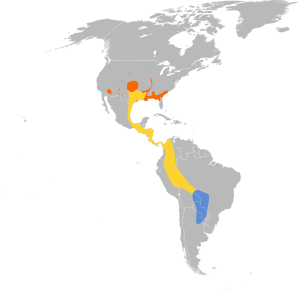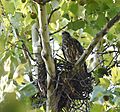Mississippi kite facts for kids
Quick facts for kids Mississippi kite |
|
|---|---|
 |
|
| In Oklahoma, USA | |
| Conservation status | |
| Scientific classification | |
| Genus: |
Ictinia
|
| Species: |
mississippiensis
|
 |
|
The Mississippi kite (Ictinia mississippiensis) is a small bird of prey. It belongs to the Accipitridae family, which includes eagles and hawks. These birds have narrow, pointed wings. They fly very gracefully, often looking like they are floating in the air. You might see several of them circling together in the sky.
Contents
What do Mississippi Kites look like?
Adult Mississippi kites are mostly gray. Their tail feathers and outer wings are a darker gray. Their heads and inner wings are a lighter gray. Male and female kites look similar, but males have slightly paler heads and necks. Young kites have striped tails and streaked bodies.
From beak to tail, they are about 12 to 15 inches (30–37 cm) long. Their wingspan, which is how wide their wings are when stretched out, is usually about 3 feet (91 cm). They weigh between 7.6 and 13.7 ounces (214 to 388 grams). Their call sounds like a high-pitched squeak, much like a squeaky toy.
What do Mississippi Kites eat?
Mississippi kites mostly eat insects. They catch these insects while flying. They enjoy eating cicadas, grasshoppers, and other insects that can harm crops. This makes them helpful to farmers. They also sometimes eat small animals like birds, frogs, lizards, and tiny mammals.
How do Mississippi Kites reproduce?
Mississippi kites lay their eggs in the central and southern parts of the United States. In recent years, they have started nesting in new places, even as far north as New Hampshire. During winter, they fly south to warmer areas in South America.
These birds usually lay two white eggs, but sometimes one or three. They build their nests out of twigs in different kinds of deciduous trees. In the last 75 years, they have started nesting in urban areas, especially in cities in the western south-central states. They are now very common in these populated areas.
Mississippi kites often nest in groups called colonies. Both parents work together to incubate the eggs and take care of the young birds. They have one group of eggs, called a clutch, each year. The eggs hatch after 30 to 32 days. The young birds leave the nest about 30 to 35 days after hatching.
About half of the Mississippi kite families successfully raise their young. Sometimes, storms or predators like raccoons and great horned owls can harm the nests. Because there are fewer predators in cities, Mississippi kites often raise more young in urban areas than in rural areas. They usually live for about 8 years.
How are Mississippi Kites protected?
The Mississippi kite is not an endangered species, meaning it's not at risk of disappearing. However, it is protected by the Migratory Bird Treaty Act of 1918. This law protects the birds, their eggs, and their nests. It means you cannot move or disturb them without special permission.
Sometimes, this can cause problems if the birds choose to nest in busy places like golf courses or schools. Mississippi kites protect their nests by diving at anything they see as a threat, including people. The best way to avoid this is to stay at least 50 yards (about 45 meters) away from their nests. If you can't avoid a nest, wearing a hat or waving your hands in the air might prevent them from touching you, but it won't stop them from diving.
Images for kids
See also
 In Spanish: Elanio del Misisipi para niños
In Spanish: Elanio del Misisipi para niños






